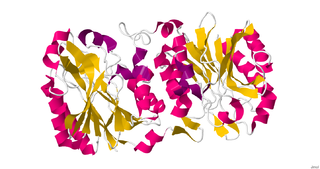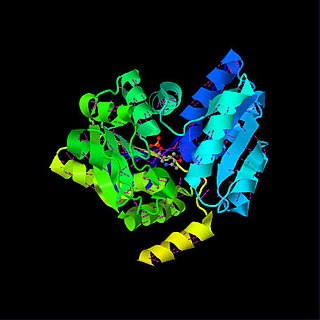In organic chemistry, a nitrile is any organic compound that has a −C≡N functional group. The prefix cyano- is used interchangeably with the term nitrile in industrial literature. Nitriles are found in many useful compounds, including methyl cyanoacrylate, used in super glue, and nitrile rubber, a nitrile-containing polymer used in latex-free laboratory and medical gloves. Nitrile rubber is also widely used as automotive and other seals since it is resistant to fuels and oils. Organic compounds containing multiple nitrile groups are known as cyanocarbons.

Nitrilase enzymes catalyse the hydrolysis of nitriles to carboxylic acids and ammonia, without the formation of "free" amide intermediates. Nitrilases are involved in natural product biosynthesis and post translational modifications in plants, animals, fungi and certain prokaryotes. Nitrilases can also be used as catalysts in preparative organic chemistry. Among others, nitrilases have been used for the resolution of racemic mixtures. Nitrilase should not be confused with nitrile hydratase which hydrolyses nitriles to amides. Nitrile hydratases are almost invariably co-expressed with an amidase, which converts the amide to the carboxylic acid. Consequently, it can sometimes be difficult to distinguish nitrilase activity from nitrile hydratase plus amidase activity.
Nitrile hydratases are mononuclear iron or non-corrinoid cobalt enzymes that catalyse the hydration of diverse nitriles to their corresponding amides

Serine dehydratase or L-serine ammonia lyase (SDH) is in the β-family of pyridoxal phosphate-dependent (PLP) enzymes. SDH is found widely in nature, but its structural and properties vary among species. SDH is found in yeast, bacteria, and the cytoplasm of mammalian hepatocytes. SDH catalyzes is the deamination of L-serine to yield pyruvate, with the release of ammonia.
In enzymology, a phenylacetaldoxime dehydratase (EC 4.99.1.7) is an enzyme that catalyzes the chemical reaction
The enzyme 1,5-anhydro-D-fructose dehydratase (EC 4.2.1.111) catalyzes the chemical reaction
The enzyme 3α,7α,12α-trihydroxy-5β-cholest-24-enoyl-CoA hydratase (EC 4.2.1.107) catalyzes the chemical reaction

The enzyme 3-dehydroquinate dehydratase (EC 4.2.1.10) catalyzes the chemical reaction
The enzyme acetylenecarboxylate hydratase (EC 4.2.1.27) catalyzes the chemical reaction

Arogenate dehydratase (ADT) (EC 4.2.1.91) is an enzyme that catalyzes the chemical reaction
The enzyme cyanide hydratase (EC 4.2.1.66) catalyzes the chemical reaction
The enzyme cyclohexyl-isocyanide hydratase (EC 4.2.1.103) catalyzes the chemical reaction
The enzyme lactoyl-CoA dehydratase (EC 4.2.1.54) catalyzes the chemical reaction

The enzyme methylthioribulose 1-phosphate dehydratase (EC .2.1.109) catalyzes the chemical reaction
The enzyme(R)-2-methylmalate dehydratase (EC 4.2.1.35) catalyzes the chemical reaction
The enzyme (S)-2-methylmalate dehydratase (EC 4.2.1.34) catalyzes the chemical reaction:
In enzymology, an aliphatic nitrilase also known as aliphatic nitrile aminohydrolase (EC 3.5.5.7) is an enzyme that catalyzes the hydrolysis of nitriles to carboxylic acids:

D-bifunctional protein (DBP), also known as peroxisomal multifunctional enzyme type 2 (MFP-2), as well as 17β-hydroxysteroid dehydrogenase type IV is a protein that in humans is encoded by the HSD17B4 gene. It's an alcohol oxidoreductase, specifically 17β-Hydroxysteroid dehydrogenase. It is involved in fatty acid β-oxidation and steroid metabolism.
Enoyl-CoA hydratase 2 is an enzyme with systematic name (3R)-3-hydroxyacyl-CoA hydro-lyase. This enzyme catalyses the following chemical reaction on D-3-hydroxyacyl-CoA
Very-long-chain (3R)-3-hydroxyacyl-CoA dehydratase (EC 4.2.1.134, PHS1 (gene), PAS2 (gene)) is an enzyme with systematic name very-long-chain (3R)-3-hydroxyacyl-CoA hydro-lyase. This enzyme catalyses the following chemical reaction






